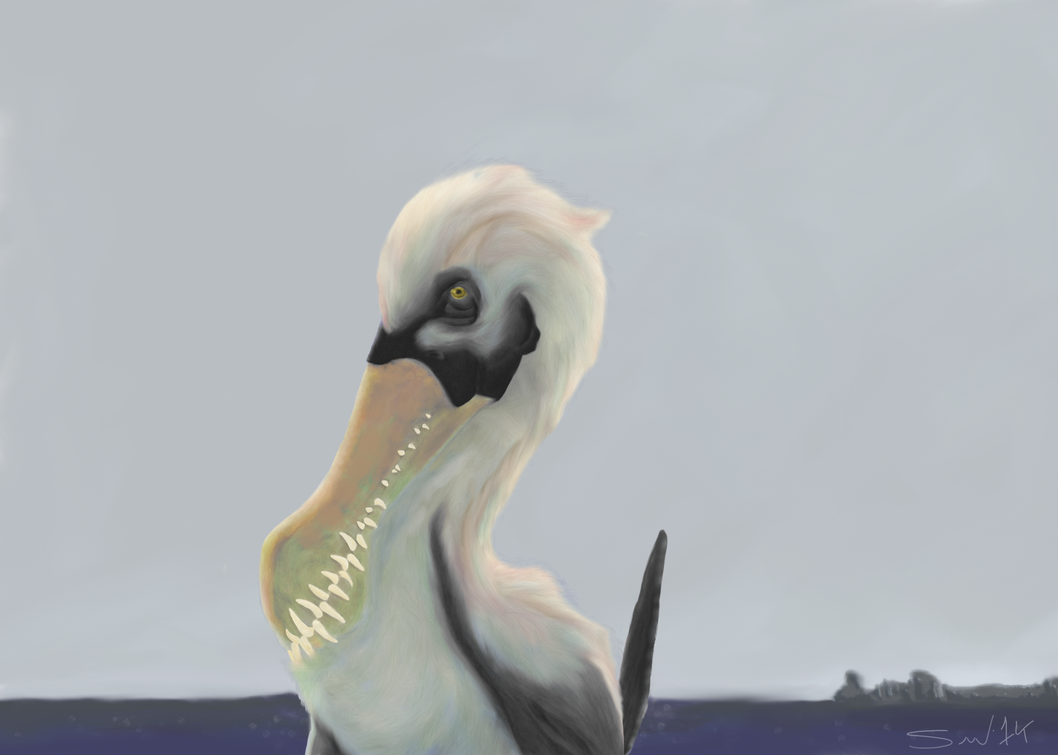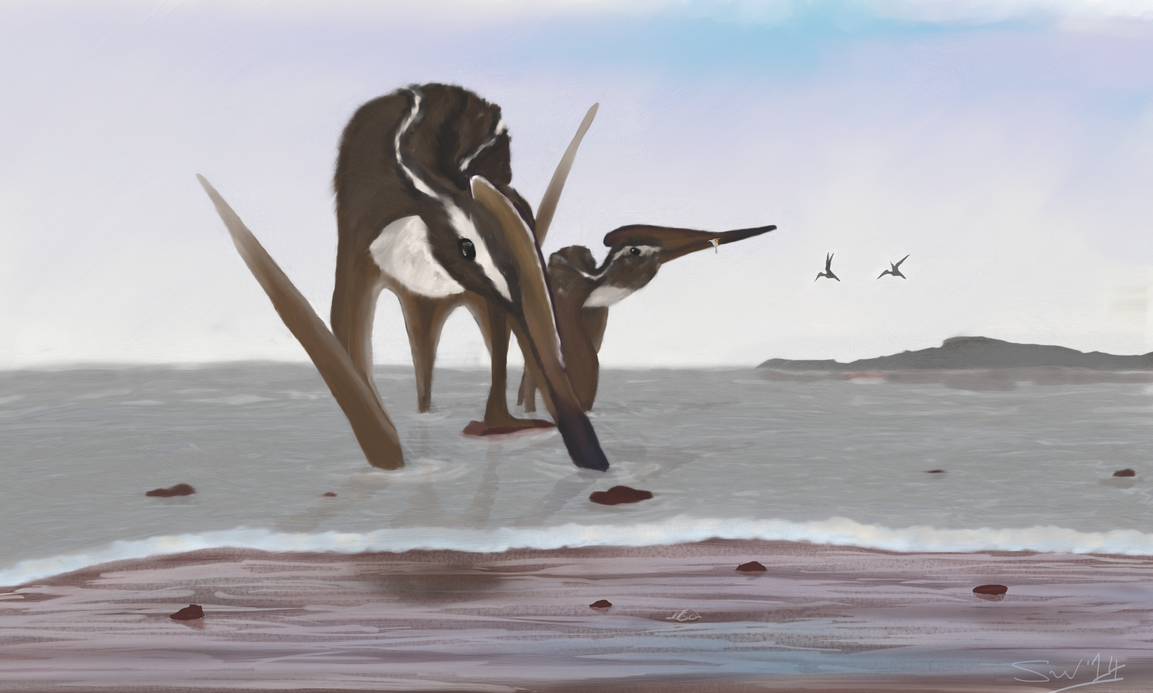The relationships
within Pterosauria have been the subject of phylogenetic debate since the 19th
Century. In the very latest 20th century it was subject to rigorous
cladistic analyses, which became more refined and comprehensive in the early
two-thousands. There have been multiple approaches to pterosaur phylogeny, tackling
both the Pterosauria as a whole and taking a ‘split approach’ -studying the
stem-group non-pterodactyloids and the pterodactyloids separately.
In a recent study (Vidovic and Martill 2014) a contentious
distribution of pterodacyloids was recovered during a cladistic analysis. The analysis
was a pterodactyloid-specific study, and the first published to use
non-pterodactyloid monofenestratans as the out-group. Being a pterodactyloid-specific
analysis it was not a completely comprehensive analysis, thus it does not hold
more “weight” than say the analysis of Andres et al. 2014. However, it is the
largest pterodactyloid analysis to date, utilising more effective methods of
extracting data from morphometrics (TNT’s continuous states function), and the characters
were scrutinized to avoid compound characters (i.e. those characters that do not
express all the information you tell them). For these reasons the new phylogeny
presents an interesting hypothesis of pterosaur relationships that should not
be dismissed without good reason.
 |
| A single most parsimonious tree of the Pterodactyloidea recovered using a TNT “new technology search”.Named nodes: 1 = Monofenestrata Lü et al. 2010 [30]; 2 = Pterodactyloidea Plieninger 1901 [31]; 3 = Ctenochasmatidae Nopcsa 1928 [32]; 4 = Lophocratia Unwin 2003 [33]; 5 = Aurorazhdarchidae fam. nov.; 6 = Ornithocheiroidea Seeley 1891 [34]; 7 = Istiodactylidae Howse et al. 2001 [35]; 8 = Pteranodontia Marsh 1876 [36]; 9 = Anhangueridae Campos and Kellner 1985 [37]; 10 = Tapejaroidea Kellner 1996 [38]; 11 = Azhdarchoidea Nesov 1984 [39]; 12 = Azhdarchidae Nesov 1984 [39]; 13 = Tapejaridae Kellner 1989 [40]. doi:10.1371/journal.pone.0110646.g006 |
Now that I have explained why the cladogram is worth
consideration, it is worth saying what is so different about it.
As I have previously mentioned the Vidovic and Martill (2014)
analysis was the first to use non-pterodactyloid monofenestratans as the out-group.
The significance of this out-group is that species of Darwinopterus (as well as Wukongopterus and Cuspicephalus) possess
the confluent nares and antorbital fenestra (nasoantorbital fenestra) that
pterodactyloids have, but in every other sense are more similar to
non-pterodactyloids. Because this non-pterodactyloid group is so close to
pterodactyloids we can be confident that Darwinopterus
can polarise the characters effectively. Perhaps due to the use of Darwinopterus as the out-group, or the
splitting down of compound characters, neither the Ctenochasmatoidea nor the Archaeopterodactyloidea
have been recovered. The Ctenochasmatoidea and Archaeopterodactyloidea each
contain the Gallodactylidae, the Ctenochasmatidae and Pterodactylus, the difference between the two is that the former is
exclusive of Germanodactylus and the
latter is inclusive of Germanodactylus.
Maisch et al. (2004) conducted a specific analysis on dsugaripteroids
(following Unwin 2003, with Ctenochasmatoidea and Germanodactylus included in Dsungaripteroidea) and concluded that Germanodactylus is paraphyletic –meaning
it contains two or more closely related genera. In the Vidovic and Martill
(2014) analysis the two Germanodactylus
species were found to be incredibly distinct, perhaps even polyphyletic
–meaning the inferred relationship is based on homoplasy (convergent
characters) rather than symplesiomorphies (shared ancestral characters). In the
analysis Germanodactylus cristatus
was found to be the sister taxon to dsungaripterids and azhdarchoids, closer to
Unwin’s (2003) hypothesis, whereas “Germanodactylus
rhamphastinus” is the sister taxon to the new family group Aurorazhdarchidae,
which is part of Archaeopterodactloidea sensu
Kellner (2003). So, neither of the most favoured hypotheses seen in other
analyses are entirely supported by this analysis. Moreover, the family groups that are
normally grouped together -Pterodactylus,
the ctenochasmatids (Ctenochasmatinae and Gnathosaurinae), Gallodactylidae and Ardeadactylus- are spread out stepwise
between the node for Pterodactyloidea and the unnamed clade containing
ornithocheiroids and Germanodactylus. The rest of the cladogram is mostly uncontroversial.
 |
| "Darwinopterus robustidens" |
Is this distribution of “ctenochasmatoids” (From now on I
will refer to both cteno. and archaeo. as “ctenochasmatoids”) illogical?
Perhaps not.
The new (since 2009) knowledge of non-pterodactyloid
monofenestratans demonstrates that many of the features originally considered
to define “ctenochasmatoids” are plesiomorphies. In the case of Vidovic and
Martill (2014) these plesiomorphies are shared by several groups making the
characters symplesiomorphies. More recently, after the paper and cladogram being discussed
were submitted and peer reviewed for publication, a paper on a new
ornithocheiroid, Hamipterus was
published (Wang et al. 2014). Hamipterus
is interesting, because it is clearly an ornithocheiroid, but possesses a long
fibrous headcrest similar to that found in Darwinopterus
and Cuspicephalus. This means that
long fibrous headcrests are certainly not confined to “ctenochasmatoids”, nor
are elongate necks, or elongate wing-metacarpals. In conclusion, there are no
obvious characters uniting “ctenochasmatoids” and therefore the taxa are ‘strung
out’ as a series of meta-taxa between the pterodactyloid node and the common ancestor of ornithocheiroids
and Germanodactylus cristatus.
 |
| Hamipterus skulls with fibrous bony headcrests |
 |
| Reconstruction of an ornithocheiroid pterosaur |
 |
| Reconstruction of aurorazhdarchid, Aerodactylus - adult and juvenile |
In conclusion, the new phylogenetic hypothesis is a challenge to the established phylogenies of the past 10 years. It will be interesting to see what happens when comprehensive analyses begin to become more refined in their character construction.
References
Bennett SC (2013) The morphology and taxonomy of the pterosaur Cycnorhamphus. Neues Jahrbuch Fur Geologie Und Palaontologie-Abhandlungen 267: 23–41. doi: 10.1127/0077-7749/2012/0295
Kellner AWA (2003) Pterosaur phylogeny and comments on the evolutionary history of the group In: Buffetaut E, Mazin MJ, editors. Evolution and Palaeobiology of Pterosaurs: Geological Society of London, Special Publications 105–137.
Maisch MW, Matzke AT, Sun G (2004) A new dsungaripteroid pterosaur from the Lower Cretaceous of the southern Junggar Basin, north-west China. Cretaceous Research 25: 625–634. doi: 10.1016/j.cretres.2004.06.002
Lü J, Ji Q, Wei X, Liu Y (2012) A new ctenochasmatoid pterosaur from the Early Cretaceous Yixian Formation of western Liaoning, China. Cretaceous Research 34: 26–30. doi: 10.1016/j.cretres.2011.09.010
Unwin DM (2003) On the phylogeny and evolutionary history of pterosaurs. In: Buffetaut E, Mazin MJ, editors. Evolution and Palaeobiology of Pterosaurs: Geological Society of London, Special Publications. 139–190.
Wellnhofer, P. (1991): The illustrated encyclopedia of pterosaurs. – 192 pp.; London (Salamander Books).
Wang X, Kellner AWA, Jiang S, Wang Q, Ma Y, Paidoula Y, Cheng X, Rodrigues T, Meng X, Zhang J, Li N, and Zhou Z (2014). Sexually Dimorphic Tridimensionally Preserved Pterosaurs and Their Eggs from China. Current Biology. Forthcoming. doi:10.1016/j.cub.2014.04.054
References
Bennett SC (2013) The morphology and taxonomy of the pterosaur Cycnorhamphus. Neues Jahrbuch Fur Geologie Und Palaontologie-Abhandlungen 267: 23–41. doi: 10.1127/0077-7749/2012/0295
Kellner AWA (2003) Pterosaur phylogeny and comments on the evolutionary history of the group In: Buffetaut E, Mazin MJ, editors. Evolution and Palaeobiology of Pterosaurs: Geological Society of London, Special Publications 105–137.
Maisch MW, Matzke AT, Sun G (2004) A new dsungaripteroid pterosaur from the Lower Cretaceous of the southern Junggar Basin, north-west China. Cretaceous Research 25: 625–634. doi: 10.1016/j.cretres.2004.06.002
Lü J, Ji Q, Wei X, Liu Y (2012) A new ctenochasmatoid pterosaur from the Early Cretaceous Yixian Formation of western Liaoning, China. Cretaceous Research 34: 26–30. doi: 10.1016/j.cretres.2011.09.010
Unwin DM (2003) On the phylogeny and evolutionary history of pterosaurs. In: Buffetaut E, Mazin MJ, editors. Evolution and Palaeobiology of Pterosaurs: Geological Society of London, Special Publications. 139–190.
Wellnhofer, P. (1991): The illustrated encyclopedia of pterosaurs. – 192 pp.; London (Salamander Books).
Wang X, Kellner AWA, Jiang S, Wang Q, Ma Y, Paidoula Y, Cheng X, Rodrigues T, Meng X, Zhang J, Li N, and Zhou Z (2014). Sexually Dimorphic Tridimensionally Preserved Pterosaurs and Their Eggs from China. Current Biology. Forthcoming. doi:10.1016/j.cub.2014.04.054
Thanks for the discussion. This topology really has me scratching my head. Don't know what to believe anymore.
ReplyDeleteOne note: " In my opinion Gallodactylidae shouldn't have its diagnosis amended excessively, instead it should be reclassified to Gallodactylinae and nest within the more inclusive Aurorazhdarchidae."
Gallodactylidae has precedence over Aurorazhdarchidae, so it would be Aurorazhdarchinae (implicitly named when Aurorazhdarchidae was named) within Gallodactylidae.
Gallodactylidae only has precedence if the families are synonymous. Gallodactylidae was erected, presumably (as there was no discussion) for the reception of pterodactyloids with very few teeth isolated to the anterior rostrum. In this phylogeny that puts it within Aurorazhdarchidae, which means if we choose to use it we should consider it a sub-family. In future it may be found outside of the bracket provided by Aurorazhdarcho and Aerodactylus, in which case it could remain classified at family level.
DeleteSince Gallodactylidae apparently lacks a phylogenetic definition, according to the same ICZN articles you cite in the Aerodactylus paper, its only "definition" is as any family-group taxon containing the genus Gallodactylus. Aurorazhdarchidae was erected specifically as a "family" under the ICZN and not just a clade, so Gallodactylidae will always have priority over any other name with an -idae ending containing Gallodactylus. An alternative would be to treat Aurorazhdarchidae as a clade and not a ranked ICZN family, in which case Aurorazhdarchidae could contain Gallodactylidae.
Delete